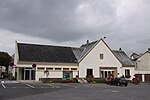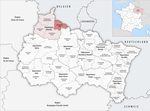Jardin botanique de Sedan
Ardennes (department) geography stubsBotanical gardens in FranceFrench garden stubsGardens in Ardennes (department)Sedan, Ardennes
The Jardin botanique de Sedan is a botanical garden and city park located on Philippoteaux Avenue beside the Place d'Alsace-Lorraine, Sedan, Ardennes, Champagne-Ardenne, France. It is open daily without charge. The garden was established in 1875 upon the demolition of the Bourbon bastion, with its plan drawn up by René Richer. A statue of Paul et Virginie beneath an umbrella, battered in the cyclone of 1905, still graces the garden. Today it contains mature trees (beech, maple, chestnut), magnolias, a rose garden with more than 50 varieties, a collection of hydrangeas, a bandstand, and a pool with fish, swans, and ducks.
Excerpt from the Wikipedia article Jardin botanique de Sedan (License: CC BY-SA 3.0, Authors).Jardin botanique de Sedan
Avenue de Verdun, Sedan
Geographical coordinates (GPS) Address Nearby Places Show on map
Geographical coordinates (GPS)
| Latitude | Longitude |
|---|---|
| N 49.6972 ° | E 4.9464 ° |
Address
Avenue de Verdun
08200 Sedan
Grand Est, France
Open on Google Maps









